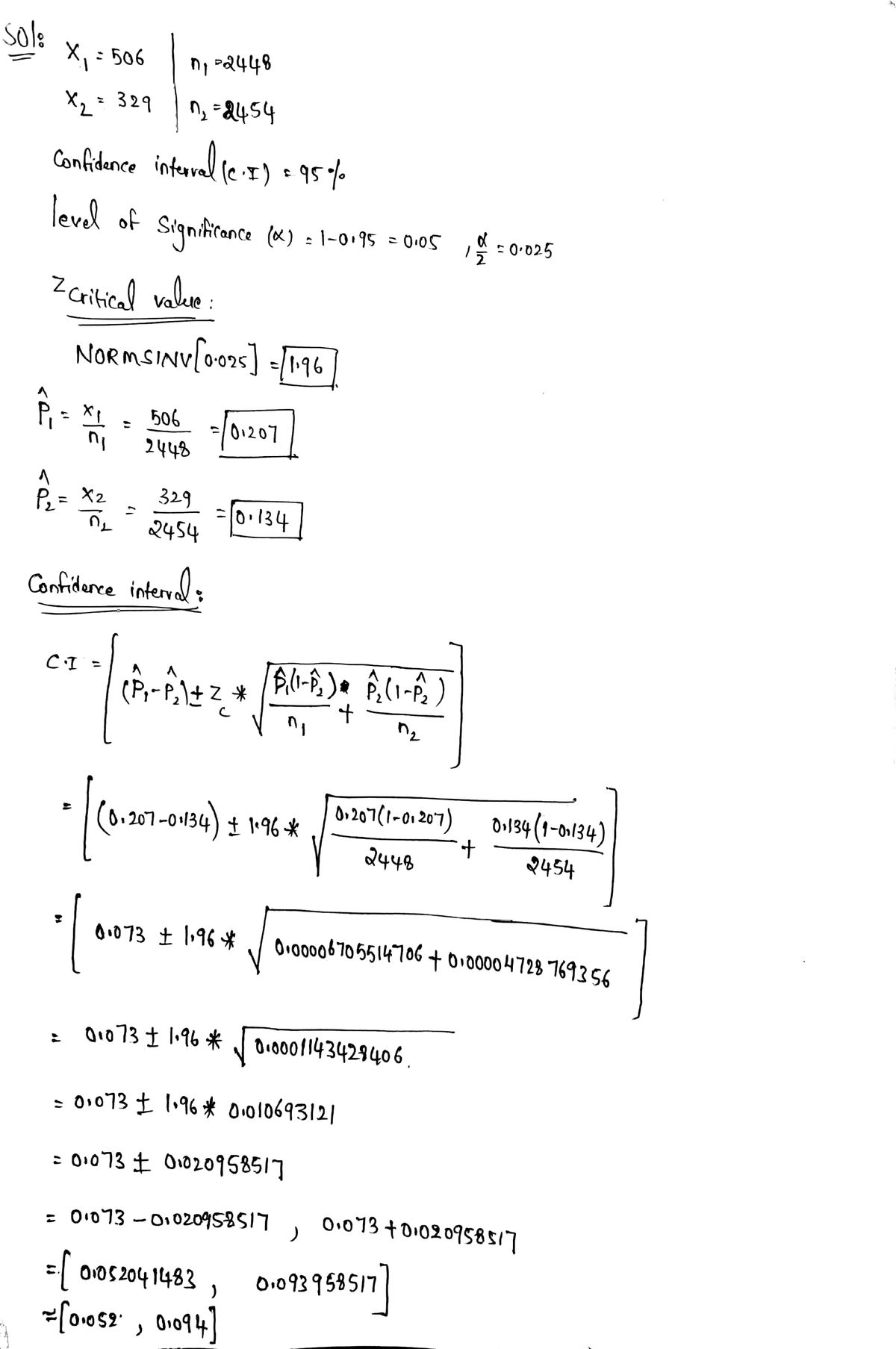A new vaccine was tested to see if it could prevent the ear infections that many infants suffer from. Babies about a year old were randomly divided into two groups. One group received vaccinations, and the other did not. The following year, only 329 of 2454 vaccinated children had ear infections, compared to 506 of 2448 unvaccinated children. Complete parts a) through c) below. a) Are the conditions for inference satisfied? OA. No. More than 10% of the population was sampled. OB. No. It was not a random sample. OC. No. The groups were not independent. D. Yes. The data were generated by a randomized experiment, less than 10% of the population was sampled, the groups were independent, and there were more than 10 successes and failures in each group. b) Let p, be the sample proportion of success in the unvaccinated group, and let p₂ be the sample proportion of success the vaccinated group. Find the 95% confidence interval for the difference in rates of ear infection, P₁-P2. The confidence interval is (%%). (Do not round until the final answer. Then round to one decimal place as needed.)
A new vaccine was tested to see if it could prevent the ear infections that many infants suffer from. Babies about a year old were randomly divided into two groups. One group received vaccinations, and the other did not. The following year, only 329 of 2454 vaccinated children had ear infections, compared to 506 of 2448 unvaccinated children. Complete parts a) through c) below. a) Are the conditions for inference satisfied? OA. No. More than 10% of the population was sampled. OB. No. It was not a random sample. OC. No. The groups were not independent. D. Yes. The data were generated by a randomized experiment, less than 10% of the population was sampled, the groups were independent, and there were more than 10 successes and failures in each group. b) Let p, be the sample proportion of success in the unvaccinated group, and let p₂ be the sample proportion of success the vaccinated group. Find the 95% confidence interval for the difference in rates of ear infection, P₁-P2. The confidence interval is (%%). (Do not round until the final answer. Then round to one decimal place as needed.)
MATLAB: An Introduction with Applications
6th Edition
ISBN:9781119256830
Author:Amos Gilat
Publisher:Amos Gilat
Chapter1: Starting With Matlab
Section: Chapter Questions
Problem 1P
Related questions
Question

Transcribed Image Text:A new vaccine was tested to see if it could prevent the ear infections that many infants suffer from. Babies about year old were randomly divided into two groups. One group received vaccinations,
and the other did not. The following year, only 329 of 2454 vaccinated children had ear infections, compared to 506 of 2448 unvaccinated children. Complete parts a) through c) below.
a) Are the conditions for inference satisfied?
OA. No. More than 10% of the population was sampled.
OB. No. It was not a random sample.
OC. No. The groups were not independent.
D. Yes. The data were generated by a randomized experiment, less than 10% of the population was sampled, the groups were independent, and there were more than 10 successes and
failures in each group.
b) Letp, be the sample proportion of success in the unvaccinated group, and let p2 be the sample proportion of success in the vaccinated group. Find the 95% confidence interval for the difference
in rates of ear infection, P₁-P2-
The confidence interval is (%,%).
(Do not round until the final answer. Then round to one decimal place as needed.)
Expert Solution
Step 1

Trending now
This is a popular solution!
Step by step
Solved in 2 steps with 2 images

Recommended textbooks for you

MATLAB: An Introduction with Applications
Statistics
ISBN:
9781119256830
Author:
Amos Gilat
Publisher:
John Wiley & Sons Inc

Probability and Statistics for Engineering and th…
Statistics
ISBN:
9781305251809
Author:
Jay L. Devore
Publisher:
Cengage Learning

Statistics for The Behavioral Sciences (MindTap C…
Statistics
ISBN:
9781305504912
Author:
Frederick J Gravetter, Larry B. Wallnau
Publisher:
Cengage Learning

MATLAB: An Introduction with Applications
Statistics
ISBN:
9781119256830
Author:
Amos Gilat
Publisher:
John Wiley & Sons Inc

Probability and Statistics for Engineering and th…
Statistics
ISBN:
9781305251809
Author:
Jay L. Devore
Publisher:
Cengage Learning

Statistics for The Behavioral Sciences (MindTap C…
Statistics
ISBN:
9781305504912
Author:
Frederick J Gravetter, Larry B. Wallnau
Publisher:
Cengage Learning

Elementary Statistics: Picturing the World (7th E…
Statistics
ISBN:
9780134683416
Author:
Ron Larson, Betsy Farber
Publisher:
PEARSON

The Basic Practice of Statistics
Statistics
ISBN:
9781319042578
Author:
David S. Moore, William I. Notz, Michael A. Fligner
Publisher:
W. H. Freeman

Introduction to the Practice of Statistics
Statistics
ISBN:
9781319013387
Author:
David S. Moore, George P. McCabe, Bruce A. Craig
Publisher:
W. H. Freeman